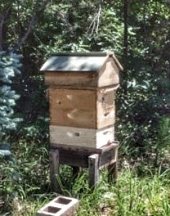




 1
1




Living in Anjou , France,
For the many not for the few
http://www.permies.com/t/80/31583/projects/Permie-Pennies-France#330873
 5
5




Leslie Russell wrote: The water smells like sulphur now, and after $3800 for a new motor and tank I can't afford to buy any expensive equipment to deal with it.
“The most important decision we make is whether we believe we live in a friendly or hostile universe.”― Albert Einstein








Sometimes the answer is nothing





John Daley Bendigo, Australia The Enemy of progress is the hope of a perfect plan
Benefits of rainfall collection https://permies.com/t/88043/benefits-rainfall-collection
GOOD DEBT/ BAD DEBT https://permies.com/t/179218/mortgages-good-debt-bad-debt




It's both hot and cold. The hot water heater is relatively new, and there was an aeration tank next to the well so the previous owner must've known about the smelly water and had it installed. The water was pumped into it and whooshed around before it was drawn to the house. I've not had smelly water before, so it was doing it's job. Several people, including my friend the water quality guy for Tampa bay water treatment facility said it just needs to be aerated, that's all. I'd been drinking it for 2 years before melting the aeration tank so I guess I'll live. I'm sure I would've keeled over by now. So assuming the hwh is fine, and the trouble is indeed that it needs aeration, any easy/simple ways to accomplish that?wayne fajkus wrote:Does it only smell when its hot? Like when you are showering or bathing?
 1
1




John Daley Bendigo, Australia The Enemy of progress is the hope of a perfect plan
Benefits of rainfall collection https://permies.com/t/88043/benefits-rainfall-collection
GOOD DEBT/ BAD DEBT https://permies.com/t/179218/mortgages-good-debt-bad-debt
 1
1




 1
1




 1
1








Sometimes the answer is nothing

 1
1




 1
1




 1
1




 1
1




 1
1




Annie Lochte wrote:I hear ya!! Hope your friend can shed some light on a relatively inexpensive solution... I have similar problem as there's so much iron in my well water everything that I use it for is rust colored... I fill jugs elsewhere for drinking water an just deal with it as Im not keen on a water softener and not real educated on filters... Nor do I have assets to fund such. I do have a couple simple filters on the line coming in the house and washing machine... But everything still turns orange. I try to buy clothes in the rust color spectrum!!!




Walt Chase wrote:
Annie Lochte wrote:I hear ya!! Hope your friend can shed some light on a relatively inexpensive solution... I have similar problem as there's so much iron in my well water everything that I use it for is rust colored... I fill jugs elsewhere for drinking water an just deal with it as Im not keen on a water softener and not real educated on filters... Nor do I have assets to fund such. I do have a couple simple filters on the line coming in the house and washing machine... But everything still turns orange. I try to buy clothes in the rust color spectrum!!!
In my experience, a water softener system using the rust remover pellets is about the only way to come close to removing, or at least reducing the high iron in water. We have the same trouble with clothes turning an orangie color over time. Whites are about completely out of the question. I wear white undershirts once or twice a week in the cooler seasons. The only way I've found to keep them white is to add Lysol toilet bowl cleaner (the blue stuff, I think the active ingredient is phosphoric acid) to the washing machine water. The Lysol will also help keep your porcelain toilet fixtures from getting too orange.
 1
1




 1
1




Nothing is impossible to a sufficiently talented fool!




Community Building 2.0: ask me about drL, the rotational-mob-grazing format for human interactions.




Joshua Myrvaagnes wrote:Would love updates, and any other ideas for water sourcing for someone not really a permaculturist but faced with this problem...in coastal North Carolina, right near the sound. I sent her this thread.
Personally I would go for catching rain off the roof and holding that in a tower up high and then using that for showers and laundry, filtering some for drinking through a berkey...but that's gotta be less expensive than the competing solution, and she still wants the water heated. Step by step. Any thoughts? Thanks!




John Daley Bendigo, Australia The Enemy of progress is the hope of a perfect plan
Benefits of rainfall collection https://permies.com/t/88043/benefits-rainfall-collection
GOOD DEBT/ BAD DEBT https://permies.com/t/179218/mortgages-good-debt-bad-debt









John Daley Bendigo, Australia The Enemy of progress is the hope of a perfect plan
Benefits of rainfall collection https://permies.com/t/88043/benefits-rainfall-collection
GOOD DEBT/ BAD DEBT https://permies.com/t/179218/mortgages-good-debt-bad-debt








John Daley Bendigo, Australia The Enemy of progress is the hope of a perfect plan
Benefits of rainfall collection https://permies.com/t/88043/benefits-rainfall-collection
GOOD DEBT/ BAD DEBT https://permies.com/t/179218/mortgages-good-debt-bad-debt




John Daley Bendigo, Australia The Enemy of progress is the hope of a perfect plan
Benefits of rainfall collection https://permies.com/t/88043/benefits-rainfall-collection
GOOD DEBT/ BAD DEBT https://permies.com/t/179218/mortgages-good-debt-bad-debt




















Where there is Liberty, there is Christ!




”John C Daley wrote:
“But I just don't know why none of you capture rain water, it is free of all the issues you speak of, does not get 'sick' with leaves dead animals or bird faeces if set up with big tanks and filters.
 3
3




Lorinne Anderson: Specializing in sick, injured, orphaned and problem wildlife for over 20 years.




If there is one thing the Wizard of Oz has taught me, it is not to trust school teachers on bicycles.




 1
1




John Daley Bendigo, Australia The Enemy of progress is the hope of a perfect plan
Benefits of rainfall collection https://permies.com/t/88043/benefits-rainfall-collection
GOOD DEBT/ BAD DEBT https://permies.com/t/179218/mortgages-good-debt-bad-debt




Lorinne Anderson: Specializing in sick, injured, orphaned and problem wildlife for over 20 years.

|
This tiny ad is made of adobe
Learn Permaculture through a little hard work
https://wheaton-labs.com/bootcamp
|







